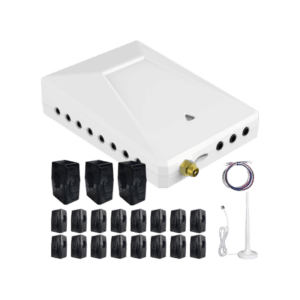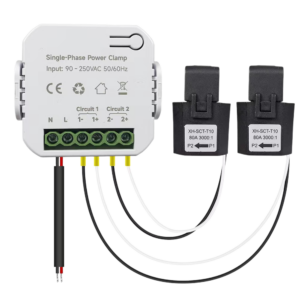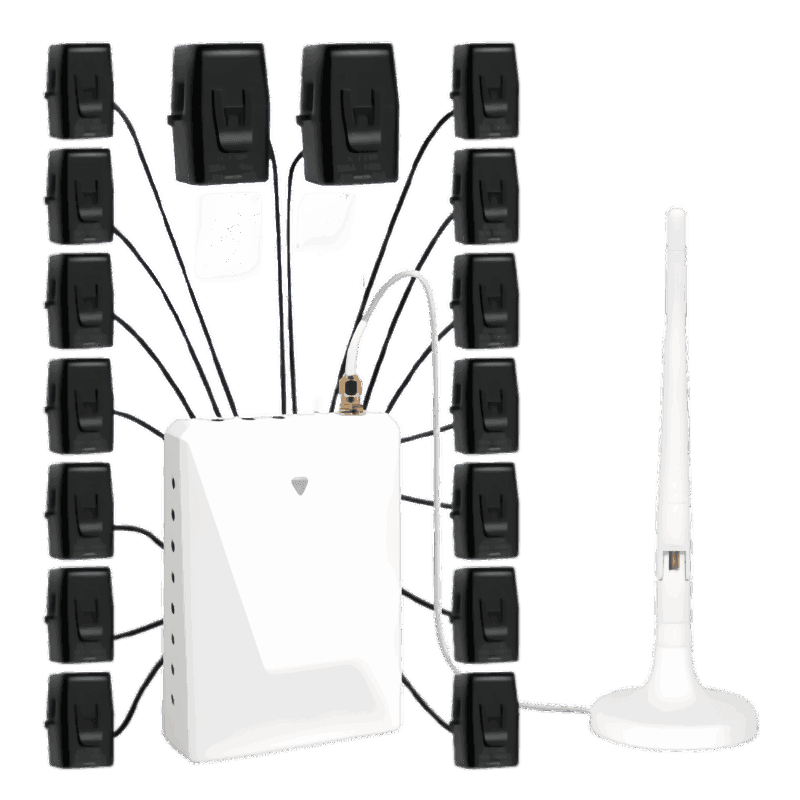Waarom is mijn energierekening deze maand zo hoog?
Het openen van je e-mail van het nutsbedrijf en een totaal zien dat 30 procent hoger is dan vorige maand, is genoeg om je ochtendkoffie te verpesten. In de Verenigde Staten blijven de elektriciteitsprijzen stijgen, volgens deAmerikaanse Energie Informatie Administratie, is het nationale tarief voor huishoudens alleen al het afgelopen jaar met meer dan 5 procent gestegen. Maar een stijgend landelijk gemiddelde is niet de enige reden waarom uw rekening plotseling stijgt.
Een hogere rekening dan normaal betekent meestaler is iets in je huis veranderd—verbruik, apparatuur of het tariefplan zelf. Voordat u het nutsbedrijf belt of ervan uitgaat dat de meter niet klopt, kunt u een paar snelle stappen ondernemen om de mogelijkheden te beperken.
Snelle zelfcontrole voordat u het nutsbedrijf belt
Als een rekening 's nachts stijgt, begin dan met eengegevenscontrolevoordat ze de schuld bij het energiebedrijf leggen.
- Vergelijk het gebruik, niet alleen de dollars
Download de afschriften van de afgelopen maand en het afgelopen jaar van uw nutsbedrijf (Duke Energy, PG&E, Con Edison – elke leverancier biedt dit aan). Bekijk het totaalkWh, niet alleen de kosten. Als het verbruik sterk is gestegen, ligt de oorzaak in uw woning. - Controleer de meter
Loop naar uw buitenmeter en noteer het nummer. Vergelijk het met de "huidige meterstand" op uw factuur. Maak snel een foto voor uw administratie. Als de meterstand lager is dan op de factuur staat, neem dan onmiddellijk contact op met het energiebedrijf. De meeste bedrijven, waaronder Con Edison, geven zelfs stapsgewijze instructies over het gebruik van de meter.hoe u uw eigen meter kunt aflezen. - Controleer de tarieven voor gebruik op basis van tijd
Veel nutsbedrijven rekenen nu hogere tarieven tijdens piekuren in de avond. In Californië bijvoorbeeld kan de elektriciteitsprijs tijdens de piekuren twee keer zo hoog zijn als het middernachttarief. Als uw huishouden de droger of vaatwasser direct na het eten aanzet, kunnen die paar avondbeurten een verrassende stijging verklaren, zelfs als het totale kWh-verbruik gelijk blijft.
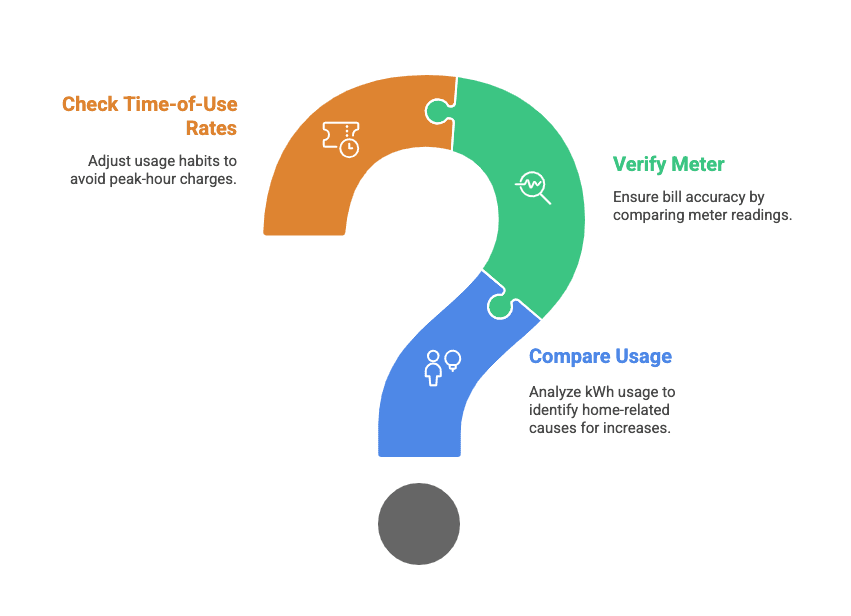
Door deze drie acties eerst uit te voeren, krijgt u concreet bewijs voordat u contact opneemt met uw energieleverancier. Het helpt u ook patronen te ontdekken – zoals een nieuw apparaat of een over het hoofd geziene gewoonte – die de rekening kunnen opdrijven.
Voor huiseigenaren die diepere antwoorden willen, eenweergave op circuitniveauis de volgende stap. Eensplit-phase thuis energiemonitorkan in realtime onthullen welke stroomonderbreker of welk apparaat het meeste stroom verbruikt en wanneer. In het volgende gedeelte bekijken we de meest voorkomende verborgen boosdoeners en hoe echte gezinnen deze hebben ontdekt.
Tien echte oorzaken van een hoge elektriciteitsrekening deze maand
De volgende stap is om te zoeken naar specifieke, bewezen redenen. Hieronder vind je tien oorzaken, afkomstig van echte Noord-Amerikaanse huizen, met typische kosten en snelle manieren om ze te controleren.
1. Seizoensgebonden verwarming en koeling kunnen uw elektriciteitsrekening deze maand hoog maken
Verwarming en koeling zijn verantwoordelijk voor40-50% van de huishoudelijke elektriciteitin veel klimaten. Een centrale airconditioning die 10 uur per dag draait, kan500 kWhin één maand - ongeveer$80–$120tegen gemiddelde tarieven in de VS. In de winter kunnen elektrische plintverwarmingen of de noodmodus van een warmtepomp het normale verbruik verdubbelen. Vergelijk de gemiddelde buitentemperatuur van deze maand met die van vorig jaar om te zien of het weer alleen de stijging verklaart.
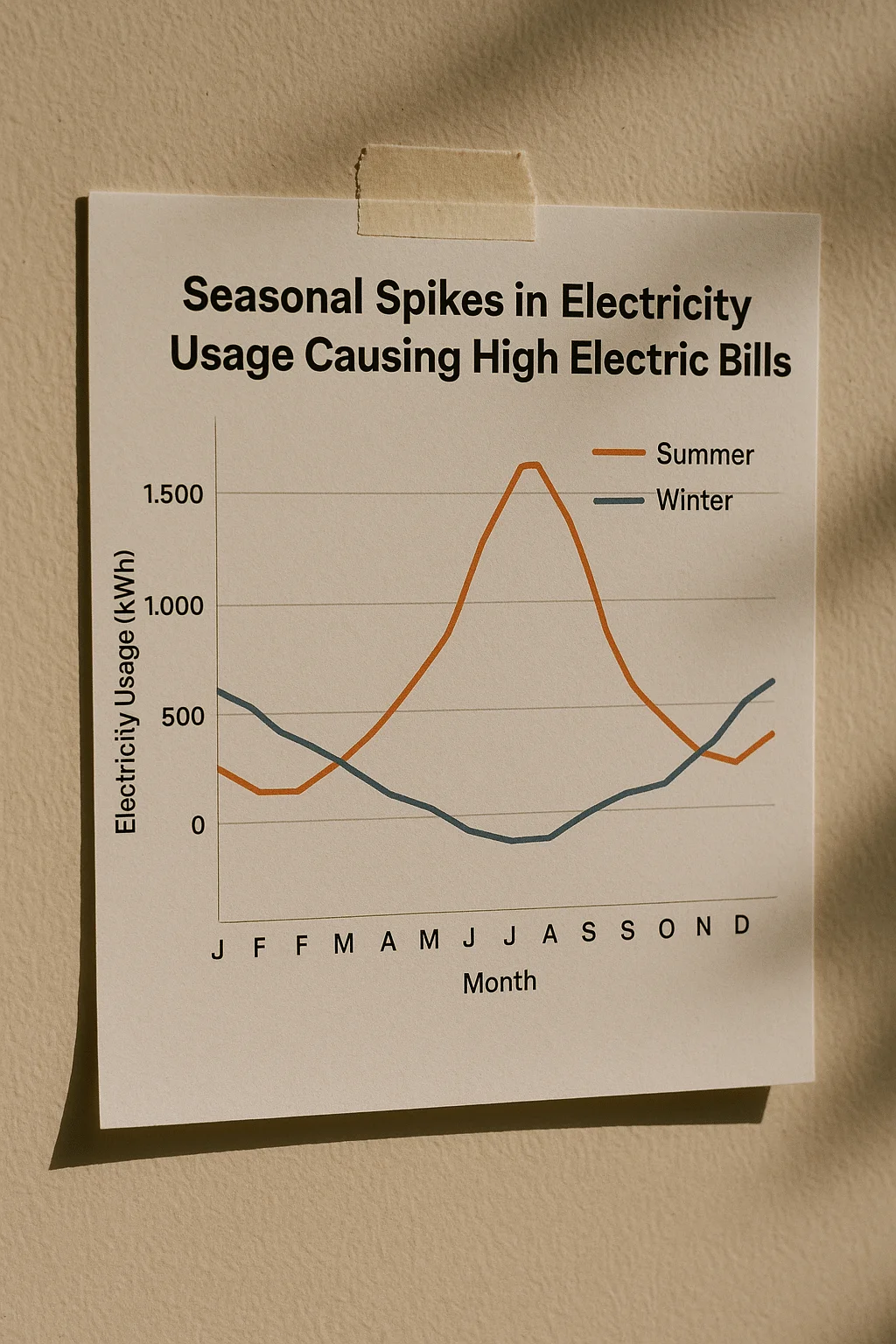
2. Verborgen "Vampierladingen"
Apparaten die nooit echt uit gaan – garagekoelkasten, oude luchtontvochtigers, kabelontvangers – verbruiken 24/7 geruisloos stroom. Het Amerikaanse ministerie van Energie schat dat deze fantoombelastingen verantwoordelijk zijn voor5–10 procentvan huishoudelijke elektriciteit. Een huiseigenaar ontdekte een vergeten diepvrieskist die 150 kWh per maand verbruikte – meer dan $ 20 tegen tarieven in het Midwest-gebied.
3. Verhogingen van nutsvoorzieningen of brandstoftoeslagen
Soms is het verbruik helemaal niet veranderd; de prijs per kWh wel. Veel energiebedrijven voegen halverwege het jaar stilletjes kosten voor "brandstofaanpassing" of "stroomkostenvergoeding" toe. Controleer de posten op uw factuur en de pagina "tariefwijzigingen" van het energiebedrijf. Een bescheiden3 centtariefverhoging op een rekening van 1.000 kWh voegt toe$30onmiddellijk.
4. Storingen aan het apparaat
Een defecte thermostaat van een boiler of een defecte koelkastcompressor kan onafgebroken draaien. Een gezin uit Colorado documenteerde een$90 maandelijkse piekHerleidbaar tot een defecte ontdooiverwarming van de koelkast. Luister naar apparaten die nooit uitschakelen, of gebruik een klem-energiemeter om een constant hoog stroomverbruik te identificeren.
5. Veranderingen in levensstijl
Thuiswerken, langdurige gasten ontvangen of de was van een pasgeborene doen, kan op een stille manier de tijd verdrijven.100–200 kWhZelfs een kleine gewoonte – de vaatwasser elke avond aanzetten in plaats van om de dag – telt mee. Houd veranderingen in bezetting of routines bij gedurende de factureringsperiode.
6. Piekverbruik tijdens gebruik
In gebieden metGebruikstijd (TOU)Prijzen – Californië, Arizona, delen van Ontario – elektriciteit kan tijdens de avondpiek twee keer zo duur zijn. Een droger van 5 kW die een uur draait voor $ 0,45/kWh in plaats van $ 0,18/kWh, kost meer.$ 1,35 per ladingVerplaats zware lasten naar daluren om direct te besparen.
7. Zonneverrassingen
Veel huiseigenaren verwachten een bijna-nulrekening na de installatie van panelen en schrikken zich rot als de kosten stijgen. Oorzaken zijn onder andere een defecte omvormer, schaduw van nieuwe bomen of een gesprongen zekering die de netmetering blokkeert. Controleer het display van de omvormer en uw monitoring-app om de werkelijke opbrengst te controleren.
8. Slechte isolatie of luchtlekken zorgen ervoor dat uw elektriciteitsrekening deze maand hoog is
Tochtende ramen en niet-afgesloten zolderluiken laten warme of gekoelde lucht ontsnappen. Een eenvoudigerookpen testof een infraroodcamera geleend van een plaatselijke bibliotheek kan lekken onthullen die$20–$40per maand in extra HVAC-bedrijfstijd.
9. Laadgewoonten voor elektrische voertuigen
Niveau-2 EV-laders trekken6–7 kW. Nachtelijk opladen tijdens piekuren kan extra kosten met zich meebrengen$40–$60naar een maandelijkse factuur. Plan het opladen 's nachts in, zodat het aansluit op de daluren.
10. Oude of te grote boilers
Elektrische boilers verbruiken doorgaans350–500 kWh per maandAls de thermostaat hoger is ingesteld dan 49 °C of als sediment de efficiëntie vermindert, kan het verbruik verdubbelen. Leeg en spoel de tank jaarlijks en controleer de thermostaatinstelling.
Hoe elke oorzaak te onderzoeken
- Controleer het gebruik per circuit: Asplit-phase thuis energiemonitorgeeft aan welke zekering springt als de airconditioning of verwarming aan staat.
- LogpatronenRegistreer uw dagelijkse kWh via het slimme meterportaal van uw energiebedrijf om plotselinge schommelingen op te sporen.
- Isoleer lasten: Schakel verdachte apparaten een paar uur uit en bekijk de live grafiek van de monitor.
Al deze problemen zijn herhaaldelijk aan de orde gekomen in forums voor huiseigenaren zoals r/HomeImprovement en r/Electricians. Het zijn de echte redenen waarom veel gezinnen zich plotseling afvragen:“Waarom is mijn energierekening deze maand zo hoog?”
Casestudy: Twee huizen, twee uitkomsten
Soms is de snelste manier om te leren kijken hoe andere huiseigenaren precies het probleem hebben opgelost waar jij mee kampt. Deze twee Noord-Amerikaanse huishoudens openden hun verklaring en dachten:“Waarom is mijn energierekening deze maand zo hoog?”—maar hun paden naar het antwoord zagen er heel verschillend uit.
Casestudy A: Maandenlang giswerk zonder monitor
Afgelopen februari ontving de familie Miller in de buitenwijken van Pennsylvania een rekening die van de ene op de andere dag een enorme klap kreeg.$120 tot $180in één cyclus. Ze controleerden de meter nog eens, deden de lichten agressiever uit en koppelden zelfs een paar elektronica los, maar niets verklaarde de extra200 kWh.
- Eerste maand: Ze gaven de koude periode de schuld.
- Tweede maand: Het weer werd warmer, maar de rekening bleef hoog.
- Derde maand: Ze huurden een elektricien in voor een volledige diagnose.
De dader bleek eenwarmwaterrecirculatiepompwaarvan de thermostaat kapot was en 24 uur per dag draaide. Tegen de tijd dat hij vervangen was, hadden de Millers er al voor betaald.bijna $ 200 aan onnodige elektriciteitplus de serviceoproep. Achteraf gezien hadden ze liever op dag één al gegevens op circuitniveau gehad.
Case Study B: Snelle detectie met een split-phase monitor
Aan de andere kant van het land, in Oregon, schafte de familie Ramirez een elektrische auto aan en maakte zich zorgen over het stijgende gebruik. Vóór de eerste volledige factureringscyclus installeerden ze eenWattPanel-2X Split-Phase Home Energiemonitorzodat ze het actuele verbruik per stroomonderbreker konden zien.
Twee weken later gaf het dashboard van de monitor een ongebruikelijke piek aan in het circuit van een vriezer in de kelder.vier keer de normale stroomopnameDe Ramirezes ontdekten dat de pakking van de vriezerdeur was gebarsten, waardoor de compressor bijna onafgebroken draaide.
- Onmiddellijke actie: Ze vervingen de pakking voor$25.
- Resultaat: Maandelijks gebruik gedaald met150 kWh, wat ongeveer bespaart$30 per maand—genoeg om de monitor binnen een paar factureringscycli te betalen.
Belangrijkste conclusies
Beide families stelden dezelfde vraag:Waarom is mijn elektriciteitsrekening deze maand zo hoog?—maar alleen de tweede had de tools om het binnen enkele dagen in plaats van maanden op te lossen. Monitoring op circuitniveau spoorde het probleem niet alleen op, maar leverde ook concrete gegevens op die het nutsbedrijf kon bevestigen, waardoor een langdurig onderzoek en onnodige kosten werden vermeden.
Waarom monitoring op circuitniveau het mysterie oplost
Na het lezen van deze casestudies is het duidelijk dat de vraag"Waarom is mijn elektriciteitsrekening deze maand zo hoog?"kunnen vaak niet worden beantwoord door alleen naar een energierekening te kijken. Je maandelijkse rekening is als het totaalbedrag op een restaurantrekening: het toont het grote bedrag, maar vertelt je nooit welk gerecht het meest heeft gekost. Om de echte energievreters te ontdekken, heb je inzicht nodig.circuit voor circuit.
De grenzen van een standaard nutsmeter
De meeste Noord-Amerikaanse huizen ontvangensplit-fase 120/240-volt serviceTwee "hete" stroomaansluitingen leveren stroom, en de energiemeter meet simpelweg de gecombineerde stroom. Zelfs met een slimme meter die het verbruik per uur registreert, kun je nog steeds niet zien of de piek van gisteravond afkomstig was van de warmtepomp boven, een defecte vriezercompressor of de game-pc van de kinderen die de hele nacht aanstond. Daarom blijven veel huiseigenaren zich afvragenWaarom is mijn elektriciteitsrekening deze maand zo hoog?zelfs na zorgvuldige zelfcontrole.
Hoe een split-phase energiemonitor voor thuis werkt
Amonitor op circuitniveauverandert dat beeld. DeWattPanel-2X Split-Phase EnergiemonitorWordt in het schakelpaneel geïnstalleerd met eenvoudige stroomtangen (CT's). Elke CT loopt rond een circuitdraad – geen herbedrading nodig – en rapporteert live gegevens aan een beveiligde wifi-hub.
- Realtime grafieken:Bekijk de stroomopname per seconde van elke stroomonderbreker.
- Detail per circuit:Volg maximaal zestien circuits met±2% nauwkeurigheidGenoeg om een defect apparaat op te lossen voordat uw energierekening omhooggaat.
- Aangepaste waarschuwingen:Stel drempelwaarden in, zodat u een pushmelding ontvangt wanneer een circuit plotseling meer trekt dan verwacht.
- Smart-Home-integratie:Compatibel met Home Assistant, Google Home en andere grote platforms.
Een erkende elektricien kan de installatie meestal in ongeveer een uur voltooien: schakel de hoofdschakelaar uit, klem de CT-sensoren vast aan de geselecteerde circuitdraden en verbind de monitor met wifi. Omdat het niet-invasief is, vervalt de garantie op de meeste panelen niet.
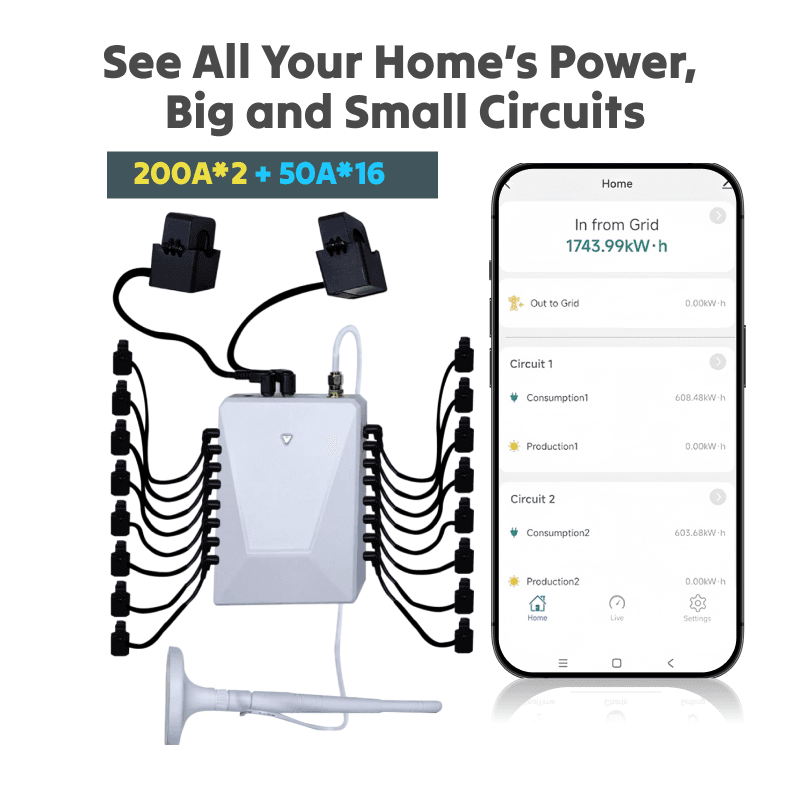
Gegevens omzetten in besparingen
Zodra de monitor draait, hoeft u niet meer te raden welk circuit de piek veroorzaakt. Als de verwarming/airco op de bovenverdieping om middernacht 3 kW verbruikt of de koelkast in de garage continu draait, ziet u het meteen. Huiseigenaren die beginnen met de vraag:"Waarom is mijn elektriciteitsrekening deze maand zo hoog?"Vaak verdienen ze de kosten van de monitor al binnen een paar factureringscycli terug door de eerste abnormale belasting die ze ontdekken, te verhelpen.
Uw rekening verlagen zodra u de schuldige hebt gevonden
Inmiddels heb je de voor de hand liggende zaken gecontroleerd, een monitor geïnstalleerd en de grote vraag beantwoord:Waarom is mijn elektriciteitsrekening deze maand zo hoog?De volgende uitdaging is om die inzichten om te zetten in lagere energierekeningen, maand na maand. Hieronder staan bewezen, datagestuurde stappen die Noord-Amerikaanse huiseigenaren nemen zodra de bron van het overtollige stroomverbruik duidelijk is.
1. Repareer of vervang probleemapparaten
Als uw gegevens op circuitniveau een defecte koelkastcompressor of een thermostaat van de boiler in de "aan"-stand laten zien, repareer of vervang deze dan onmiddellijk. Eén defect apparaat kan energieverspilling veroorzaken.150–300 kWhelke maand.
Fooi:Veel nutsbedrijven bieden kortingen op Energy Star-vervangingen. Controleer uw lokale programma voordat u koopt.
2. Verplaats zware lasten naar daluren
Zelfs als uw totale verbruik stabiel blijft,GebruikstijdPrijzen kunnen de kosten 's avonds verdubbelen. Zodra uw monitor laat zien welke apparaten het meeste stroom verbruiken, programmeert u slimme stekkers of timers om die apparaten 's nachts te laten werken. Een gezin in Ontario bespaarde$35 per maanddoor het opladen van elektrische voertuigen te verplaatsen naar middernacht.
3. Draai de envelop dicht
Uw monitor kan aangeven dat de HVAC-installatie veel langer draait dan verwacht. Dat is vaak een teken vanluchtlekken of slechte isolatie.
- Dicht zolderluiken, deuren en raamopeningen af.
- Als u last heeft van tocht, kies dan voor moderne ramen met dubbel glas.
Deze stappen verkorten de looptijd en kunnen de winterrekeningen met 50% verlagen.10–20 %.
4. Koppel monitoring aan slimme thermostaten
Gebruik uw realtime gegevens om de thermostaatschema's te sturen. Door de instelwaarde te verlagen,2 °F 's nachtstrimt ongeveer5 %van verwarmingskosten.Een wifi-thermostaat gekoppeld aan uw thuisenergiemonitorzorgt ervoor dat deze aanpassingen automatisch gebeuren.
5. Sluit u aan bij een kortings- of vraagresponsprogramma van nutsbedrijven
Veel nutsbedrijven, zoals die van PG&E,SmartRate, Con Edison's Smart Usage en andere: betaal klanten die hun verbruik verminderen tijdens piekmomenten. Nadat uw monitor flexibele lasten heeft geïdentificeerd, kunt u zich vol vertrouwen inschrijven en zonder giswerk credits verdienen.
Kortom:als je eenmaal hebt ontdektwaarom uw elektriciteitsrekening deze maand zo hoog isDe echte besparingen komen voort uit het handelen op basis van die kennis. Of het nu gaat om een snelle reparatie van de pakking, een slimmere planning of een isolatie-upgrade, de gegevens van uw split-phase monitor veranderen een mysterie in een beheersbare takenlijst en houden toekomstige rekeningen voorspelbaar.
FAQ: Snelle antwoorden op veelgestelde vragen
Waarom is mijn elektriciteitsrekening deze wintermaand zo hoog?
Elektrische weerstandsverwarming, straalkachels en ontdooicycli met warmtepomp verbruiken enorm veel stroom wanneer de temperatuur daalt. Zelfs huizen met gasgestookte cv-ketels zien hogere energierekeningen omdat ventilatormotoren en luchtbevochtigers langer draaien. Vergelijk uw huidige kWh-verbruik met de winteropgave van vorig jaar – alleen al het weer kan een stijging van 20% verklaren.
Waarom is mijn energierekening deze maand zo hoog?
Oudere appartementencomplexen hebben vaak een slechte isolatie en tochtige ramen. Raamverwarming of airconditioners draaien constant om de warmte bij te houden. Als uw appartement muren deelt met andere appartementen, maar een eigen meter heeft, betaalt u mogelijk meer voor geconditioneerde lucht dan u denkt.
Waarom is mijn energierekening deze maand zo hoog door de zonnepanelen?
Eigenaren van zonnepanelen gaan er soms van uit dat de netstroom bijna nul zal zijn. Maar storingen in de omvormer, schaduw van nieuwe bomen of een gesprongen zekering kunnen de opwekking aanzienlijk verminderen. Controleer altijd de dagelijkse opbrengst van uw omvormer en het netmeteringrapport van uw energiebedrijf.
Kan een energiemonitor voor thuis mijn energierekening direct verlagen?
De monitor zelf verlaagt het verbruik niet, maar door te laten zien welke circuits pieken – vaak binnen enkele uren – kunt u problemen oplossen vóór de volgende afrekening. Veel gezinnen verdienen de kosten terug in één of twee factureringstermijnen.
Is het veilig om een split-phase monitor te installeren?
Ja, indien geïnstalleerd door een erkende elektricien. DeWattPanel-2X Split-Phase Energiemonitormaakt gebruik van stroomtangtransformatoren, waardoor er geen herbedrading nodig is en de hoofdschakelaar tijdens de installatie is uitgeschakeld.
Laatste gedachten en volgende stappen
Een schokkende rekening betekent niet dat je machteloos bent. Begin met een zorgvuldige vergelijking van rekeningen, controleer de meter en breng je gewoonten in kaart. Zet vervolgens technologie in de strijd:split-phase thuis energiemonitorbiedt inzicht op stroomcircuitniveau dat uw energiemeter nooit zou kunnen bieden.
Stop met gissen. Volg elk circuit vóór uw volgende statement met deWattPanel-2X Split-Phase Energiemonitor.
